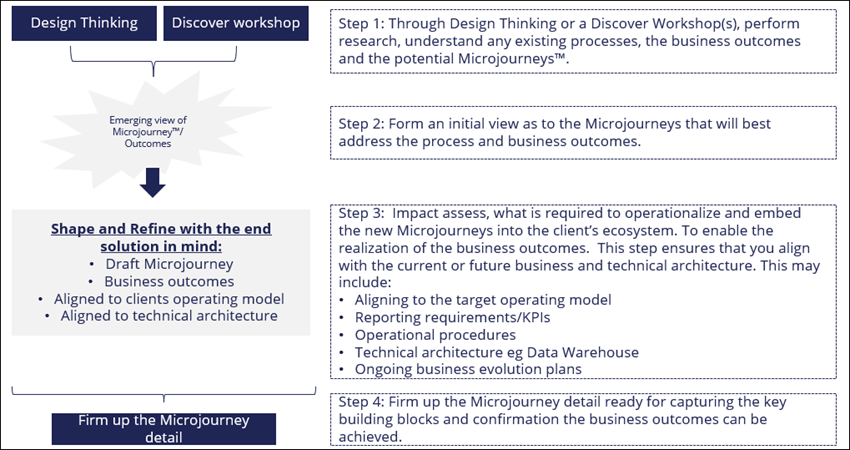
Microjourney identification
Microjourney identification
In Pega Express™, you find different techniques to help identify your Microjourney™. This topic focuses on using business outcomes to prioritize the right Microjourney for your initial release, known as a Minimum Lovable Product (MLP). By identifying your Microjourney, you can begin to outline the solution you are going to build in the Pega Platform application™.
Consider the following two approaches to identify your Microjourney:
- A design sprint (For more details, see the Pega Academy module Design Strategy)
- A traditional Discover workshop
The Discover workshop approach
If a Design Sprint is not a good fit for your organization, consider a traditional Discover workshop. In a Discover workshop, you research the current processes (and user needs), understanding the pain points, and desired business goals. Attendees then make a recommendation as to the best Microjourney solution to achieve the business outcomes.
Guidelines for setting up and leading a Discover workshop:
- Create a detailed agenda for your visit/workshop.
- Identify and secure the key business stakeholders.
- Ensure real end users participate in your research.
- Attend real life calls and touchpoints to witness firsthand the current experience.
- Review any current process documents or maps.
- Walk through and map the existing high-level journeys. Break these down into smaller pieces or Microjourneys.
- Capture the Microjourney key building blocks as you go - channels, personas, data, and integrations.
- Obtain the supporting data for the business outcomes.
- Tease out and understand pain points and bottlenecks.
- Forecast any changes on the horizon that may have an impact on the project.
Once the Discover workshop or design sprint is complete, you have enough information to select a Microjourney with the right impact and complexity.
Microjourney and solution definition
Whether your team uses a Design Sprint or a more traditional workshop approach to identify the emerging Microjourney (which best achieves the client's business outcomes), your next step is to firm up the Microjourney with an end-solution in mind.
The following image guides you step-by-step to ensure the Microjourney is reviewed from both a business and technical architecture perspective. Following these steps ensures you consider a holistic solution that integrates and works in the client's current or future organizational design.
Step 1: Through Design Thinking or a Discover Workshop(s), perform research, understand any existing processes, the business outcomes and the potential Microjourneys™.
Step 2: Form an initial view as to the Microjourneys that will best address the process and business outcomes.
Step 3: Impact assess, what is required to operationalize and embed the new Microjourneys into the client’s ecosystem. To enable the realization of the business outcomes. This step ensures that you align with the current or future business and technical architecture. This may include:
- Aligning to the target operating model
- Reporting requirements/KPIs
- Operational procedures
- Technical architecture eg Data Warehouse
- Ongoing business evolution plans
Step 4: Firm up the Microjourney detail ready for capturing the key building blocks and confirmation the business outcomes can be achieved.
Check your knowledge with the following interaction.
This Topic is available in the following Module:
If you are having problems with your training, please review the Pega Academy Support FAQs.
Want to help us improve this content?
